
Word of the Day: Histrionic
Paul Schleifer
Histrionic without a final –s is an adjective that means “overly dramatic.” If you add a final –s, you turn it into a noun meaning “melodramatic behavior designed to attract attention” (OED). The adjective form can mean “of or concerning actors or acting,” and it also can mean “denoting a personality disorder marked by shallow volatile emotions and attention-seeking behavior,” though I have to admit, as a former thespian, that I really don’t like how “shallow volatile emotions and attention-seeking behavior” is thus connected with acting.
According to www.etymonline.com, the word in English dates from the “1640s, from French histrionique ‘pertaining to an actor,’ from stem of Latin histrio (genitive histrionis) ‘actor,’ a word said to be of Etruscan origin. The literal sense in English is from 1759. The earlier adjective was histrionical (1550s).” So despite the similarity in sound, histrionic should in no way be confused with hysteria, which comes “from Greek hystera ‘womb,’ from PIE *udtero-, variant of *udero- ‘abdomen, womb, stomach’ (see uterus). Originally defined as a neurotic condition peculiar to women and thought to be caused by a dysfunction of the uterus.”
Today, May 12, would have been the 111th birthday of Katherine Hepburn, had she lived. She died in 2003 at 96 years old. She was, arguably, the greatest film actor of the 20th century.
She grew up in a privileged home and attended a relatively exclusive college, Bryn Mawr, where she began studying acting. After college, she tried to go pro. Looking back on her career, and given her immense talent, one might assume that she was an instant success, but that would be false. She was hired and fired a number of times by Broadway directors and producers. When she got to Hollywood, she had some early success, but there were also failures, such as 1934’s Spitfire, in which Hepburn played an uneducated mountain girl named Trigger Hicks, and writing that out makes it clear how poorly she was cast for such a role. According to Scott A. Berg in Kate Remembered, she kept a photograph of herself in that role in her bedroom to remind her to stay humble.
In the mid to later 1930s, she experienced a number of screen failures with only an occasional success, and her career began to falter—she was labeled “box office poison” by the Independent Theatre Owners of America. Keep in mind that, at this time, actors were under contract to a specific movie studio and were often assigned roles. Hepburn bought out her contract with RKO so that she could avoid doing B movies, but even after doing so, her movie career continued to falter. Finally, she left Hollywood to revive her stage career.
He signed on to play the lead in Philip Barry’s The Philadelphia Story, a play full of fast talking, quick-witted characters in Philadelphia’s elite social circles. One might say that the part was made for Hepburn, and Howard Hughes, who was her romantic partner in 1938, bought the movie rights to the play even before its debut. The play toured first to critical acclaim and financial success, and then opened on Broadway at the Schubert, playing 417 performances before going out on a second U.S. tour.
Hepburn and Hughes sold the movie rights to MGM under the condition that Hepburn play the leading female role, as she had done on Broadway. She also got the studio to get George Cukor, her favorite director, Cary Grant, and Jimmy Stewart. According to Scott Berg, “Before filming began, Hepburn “da or something. A lot of people want to see me fall flat on my face.’ Thus the film began with Grant knocking the actress flat on her backside. Berg describes how the character was crafted to have audiences ‘laugh at her enough that they would ultimately sympathize with her,’ which Hepburn felt was crucial in ‘recreating’ her public image (https://en.wikipedia.org/wiki/Katharine_Hepburn#cite_note-Berg_2004_p._90-65). The Philadelphia Story was one of the biggest hits of 1940 and earned Hepburn an Academy Award nomination for Best Actress. She followed up that success with Woman of the Year, co-starring Spencer Tracy, with whom Hepburn would collaborate for many years, both on and off the screen.
I’m not going to review Hepburn’s entire career, which included 12 nominations and 4 wins for Best Actress. Let me just list some of the films that I think were the highlights:
The Philadelphia Story (1940)
The African Queen (1951)
Suddenly Last Summer (1959)
Guess Who’s Coming to Dinner (1967)
The Lion in Winter (1968)
On Golden Pond (1981)
Hepburn’s success is undeniable, though some of criticized her for a lack of range. It is reported that Dorothy Parker once said that Hepburn “ran the gamut of emotions from A to B,” or something like that—there are various accounts. Still, there is much evidence that Hepburn worked very hard at her chosen craft.
One might say that she was histrionic in the best possible sense of the word.
The image is a screenshot, by Anthony Harvey, of Katherine Hepburn as Eleanor of Aquitaine in the 1968 film The Lion in Winter, co-starring Peter O’Toole.